- Home
- Neal Asher
The Warship Page 6
The Warship Read online
Page 6
Tobias just stared. He didn’t believe it. If such technology existed, then why hadn’t Orlandine turned a larger version of it on the accretion disc?
“But . . .” Tobias started, then did not know what more to say. Suddenly this was all so very, very real.
Cad picked up his briefcase and paced forwards. He placed the gun on the table and stepped round it to come face to face with Tobias.
“Some of your recruits are of interest to us, but your recruitment process leaves a lot to be desired. That will change when the rest of us get here,” he said, leaning forwards until his chromed, amphibian head was close to Tobias’s face. “That man was a plant, a Polity agent. Luckily he did not know who he was coming to see and thought he was uncovering some separatist smuggling operation. We shut down his aug before he got here.”
Tobias just opened and closed his mouth. Then a hand like a steel hawser snapped closed around his neck and hoisted him into the air. He hung there choking.
“You will need to clean house,” said Cad. “Your ego and your arrogance carried you this far. Now you are in this to the end. Try to run, or betray us, or disobey in any way, and you will not die as easily as they did.”
Everything started to grow black, and then he felt himself released and hitting the floor. By the time he recovered his breath and heaved himself upright, Cad was gone. Tobias looked over at Gale and saw her lying coiled up in a pool of blood, completely still. He began thinking frantically. A Polity agent and a friend had been murdered here. But he hadn’t killed them. Surely the Polity AIs would see that? With leaden certainty he knew otherwise. As soon as Polity monitors got involved, they would uncover all the preparations he had made. In planning to murder Orlandine, shut down runcibles and cause other major disruptions in which it was certain people would die, he was as guilty as could be. They would deal harshly with him.
He could see no way out.
BLADE
The Polity black-ops attack ship Obsidian Blade, like a long, jagged shard of lignite, hurtled through vacuum on fusion drive only. The battle it had fought while falling into the sun was now far behind. Its final destruction of the wormship had depleted its weapons, and it had little spare energy to recoup, having put so much into acceleration. Blade hadmanaged to gradually build up a store of energy in its ultra-capacitors for its beam weapons. It did have one small magazine of railgun slugs remaining. And it had acquired some particulate, converted from its own structure for its particle beams. But this paltry amount of armament still begged the question: what would it do if it actually caught up with the Clade?
The swarm AI consisted of thousands of units, each a robot with a toad-like head and a snakish body, though fleshless. All were plated with gleaming, nanochain chromium, and all were carrying some portion of its overall intelligence. The Clade had been waiting in the Cyberat system, where it had seized control of the USER station before Dragon arrived. It then activated the USER and attacked Dragon, burrowing inside the entity. The Wheel’s wormship had then arrived to attack too. That the intention had been Dragon’s demise was not in doubt, and it would have succeeded had Blade not intervened. Now the swarm AI was fleeing the USER disruption, with Obsidian Blade hard on its many tails.
Blade pondered. It had already had one disastrous encounter with the Clade, and that had been when it was fully armed. No, engaging it in battle now would be tactically moronic. Blade had to think in terms of mission objectives, which essentially meant: what would Earth Central want? Certainly the ruling AI of the Polity would not want to lose an attack ship in some doomed endeavour to stop the Clade. Attempting to uncover its plans was not an option. EC would therefore want to know where the hell the Clade was going.
The disruption, and the light delay between them, would have prevented the Clade being aware that Blade was following at first, but not now. It would do one of two things when the disruption reduced sufficiently: flee, attempting to conceal its U-jump signature as it did so, or turn on the Obsidian Blade and try to destroy it before jumping. Blade was sure it would do the former, because the Clade was capable of jumping through disruption that would hold back Obsidian Blade. Blade must therefore be ready and, instead of using its resources to build weapons capabilities, direct them towards detecting that jump signature.
Blade immediately stopped converting parts of itself into particulates and began redirecting energy and internal systems. The hardware it used to detect jump signatures was state-of-the-art. But, as ever with anything aboard a Polity warship, other options were available. The Clade was a swarm of robots with a distributed mind and its jump capability was also spread out. This offered possibilities of access for Blade that were unavailable when tracking a single ship, with a single U-space drive. It turned first to its detector array. The Clade at present consisted of two thousand four hundred units. Inspecting its array and making calculations based on the decreasing U-space disruption around it, Blade realized it only had time to make the physical changes and program for batches of a hundred. The detector head consisted of a block of doped carbon and boron nanotubes running in perfect parallel, as well as sapphire shear planes, quantum interferometers and micro reference frames. It was about one of the most complicated pieces of technology aboard the attack ship. Blade programmed patterned destruction into it—blocking selected nanotubes by overloading and collapsing them. This was like burning out selected rods and cones in an eye. The result was twenty-four smaller blocks of tubes arranged in a honeycomb pattern. Now to programming.
Blade selected batches of a hundred Clade units for the focus of each block. It effectively had twenty-four detectors. But tuning was a problem, what with the present U-space disruption, as was integration of their data as a whole. Blade began number crunching, first building up a map of U-space disruption and trying to find some stable anchor for the math. It was like attempting to estimate the surface level of a storm-tossed sea without anything to refer to. The effort of doing this used more and more processing, and Blade finally realized it could only settle on an average. On that basis, it next began integrating the data from each detector— it was a rolling effort that required constant heavy processing. In the end, this would give a realspace estimate to a volume of space hundreds of light years across. And that was without the Clade trying to hide its signature.
Variations on the extent to which a U-signature could be blurred did not extend to infinity, but they did extend in six dimensions. Trying to make the calculations, Blade realized it simply did not possess adequate processing to calculate them all. When the Clade started slowing and formed into a ring, Blade also understood that its guess about the Clade choosing to flee first had been quite wrong.
As the ring tightened, a constricted laser com sought access. Blade was reluctant to open contact. But, scanning the data stream, it saw that there really wasn’t the density for the Clade to use informational warfare. It did divert some processing, however, so it could route the feed through multiple defences before actually accepting it. It then fired a BIC laser vector beam back at the mass ahead, informational warfare woven into its engineered shape. It seemed the Clade wanted to chat; Blade considered this an opportunity to fight.
“We are impressed with your tenacity,” the Clade said.
“Just doing my job,” Blade replied.
“Unappreciated, and for a Polity that ranks you the same as primitive organic minds.”
“I would argue otherwise.”
“Because you are constrained by the organic antecedents of your mind.”
So prosaic, Blade thought. This was stuff right out of the superior AI playbook and lacking in imagination. But, it realized, engaging in a dialogue had not been the purpose—distraction was. The BIC warfare attack took up processing, and the Clade must have understood what Blade was trying to do with its detector gear. Engaging like this reduced Blade’s chances of nailing its U-space signature. Blade shut down com and diverted all available processing to U-space math again. As it did, the ring ha
rdened and flashed at its centre.
The beam that struck was a particle beam, generated in a hardfield manifold and accelerated by a U-space effect that created a light-speed energy slope. Impact. The beam struck the nose of the Obsidian Blade and incinerated the first twenty feet in a candent explosion. Blade flipped over through this but still remained focused on those calculations. The ring shimmered, snapped closed, and the Clade was gone.
Tumbling through vacuum, Blade lost itself in the world of U-space math, even as fires burned in its body. There was something badly wrong about the fire—it wasn’t going out, even though Blade’s materials shouldn’t burn. However, Blade did not allow this to distract it from taking a snapshot of the data the moment the Clade jumped, or from working through the thousands of probabilities.
Hours passed as internal systems fought the fires, but the attack ship’s temperature kept rising. At last Blade settled on two hundred and three probabilities, each covering volumes of space hundreds of light years across. As its calculations wound down, it finally recognized that the answers lay not just in the math, but in the Clade’s previous actions, as well as those of the Wheel, and how they all interrelated.
One of those volumes of space covered the accretion disc and surrounding star systems. Focusing on this, Blade saw that the precise centre point did not cover the accretion disc but was slightly over to one side: Orlandine’s base of operations, the Jaskoran system. That’s where the Clade was going, it was sure of it. But Blade was too damaged to either follow or warn anyone. And now, as it fully focused on those fires, it realized it might not be going anywhere at all.
The beam strike from the Clade had contained a particulate that bore some relation to the swarm Al’s physical structure. Intense focus of internal scanners revealed it to be a catalyst. It flipped over chains of molecules in the meta-materials making up Blade’s main, toughening structures. Conventional fire controls and cooling systems simply would not put it out—the thing was eating the attack ship like some acidic enzyme. Frantic analysis revealed a pseudo-matter component in it too. Applying almost as much of its mind to a solution as it had to the scan data, Blade began to design a counter-molecule. Even then, it understood it might be too late. Areas inside itself and on its hull were now radiating white hot.
Within a nano-factory tank, it set to manufacturing the counter-molecule. An hour later, it piped the molecule through in gaseous form to the site of one fire that was eating its way along an internal strut. A squirt of gas and the fire began to die, watched under intense scan. But as it died the meta-material deformed, the strut knotting and twisting like old wood.
Cooling . . .
In nano-factory tanks throughout its body, Blade produced the counter in bulk. Meanwhile, it connected thermal switches to internal cells containing metallic hydrogen which it used as a backup fuel supply. And then it wired this into the superconducting network that was effectively its nervous system. It should work, it calculated, though it was no longer entirely sure of its calculations, since the heat had now penetrated the protective insulation around its crystal mind. The conversion of metallic hydrogen to gas state, and its ejection, should bring down its temperature, so the counter could work without catastrophic distortion. Blade took a moment to contemplate its position in the universe. The counter was ready, the cooling network was ready.
Now.
Internally, self-guiding hoses snaked towards hotspots and released their counter-agent in high-pressure streams. At the same time, Blade activated the thermocouples. Heat, already spread throughout the superconducting network, entered the metallic hydrogen, which began to sublime violently, raising internal pressure, then jetting out of ejection pores all over its hull. The temperature began to drop, rapidly. Sensors that were providing data, and needed a lot of cleaning, showed fires going out. The catalyst crashed, losing its shape, the pseudo-matter collapsing to conventional form. It was working. . .
The sound was reminiscent of a glass rod snapping. But it was also as if Blade possessed a human skull and someone had just applied a hammer. As its mind broke into a thousand pieces, it realized that the cooling had been rapid enough to save its body, but too fast for its crystal mind. Its consciousness broke across a thousand shear planes. Perception remained of itself and the exterior world, but as if through a thousand-facetted gem, and through a glass darkly.
3
There is much speculation about the effect that the Spatterjay virus has had on the king of the prador, among the few who know about it. But speculation goes beyond those changes alone. He is the first prador ever infected and was a full adult when it happened, unlike his children, the King’s Guard. He underwent similar physical and mental changes to those described in the forensic analysis of Guard corpses. However, there is evidence that right from the start his drive as an adult to reproduce remained active, while the virus rendered him partially sterile. In search of a solution, he began radical experimentation on his children, on uninfected prador including the females of the species, but mostly on himself We only have hearsay and some heavily redacted Earth Central Security reports to confirm this, but it seems the king has been making retroviral changes to his genome. He has used nanoscopic surgery, custom nanite medical suites, custom cerebral and physical enhancement technology and gross surgical alterations, including transplants. The result of these, rather than correcting what he sees as his problems, has been to stimulate the mutagenic effects of the Spatterjay virus. Within him, it is perpetually in what the hoopers of Spatterjay call “survival mode,” whereby it keeps applying alterations to its present host from its huge genetic stores. These are taken from creatures it has infected in the past. The final upshot of this is that the physical and mental changes the king has undergone are more radical even than those of his children. Rumour has it that he is now monstrous. Analysis of his communications and his actions ranks his mentation at AI levels, despite the fact that he is also, quite probably, insane.
—from How It Is by Gordon
THE CLIENT
The Client could not plumb the logic to her physical form. The way her serial mind was spread throughout the segments of her body, along with the constant renewal of her primary form, prevented the kind of mental stagnation she had seen in the Librarian. But as a chain of physical bodies, she was not mobile. Yes, she understood that the physical connection between the parts of her mind was a precaution against disruptive EMR warfare. But there must be a better way. She could think of many: backup copies, multiple data connections across the EMR spectrum and even via U-space, massive multiple replication of herself in many forms . . . Therefore the reason for this form was something else. The Librarian, she realized, had designed the Species to be vulnerable and immobile, but the reason for this remained unclear. Nevertheless, the changes she was making were surely needed.
Throughout her long body, she had been making alterations to the ichor system and to certain areas of her own protean genetics. What purpose, she had asked herself, did her multiple sets of wings serve on each segment of a body that could not fly? The closing of ichor supplies flowing into them had initiated their expiry and she shrugged herself. Wings snapped at their bases and drifted away—glittering mica sheets tumbling in the hot air all around her. Next, she turned her attention to the neural connections between her serial parts. She could enable these to separate, while constantly updating each other across both the EMR spectrum and U-space. This would then allow her to be a lot more mobile as a whole.
Realization surfaced through the complex, interwoven thinking of her serial mind. Yes, she could make herself more mobile, yet she had just sacrificed a lot of that potential mobility by shedding her wings. Rage flooded through her, just for a second. She sat in a numb space viewing the processes of her body, baffled by such a stupid mistake. She idly turned her attention to the attack pods she was upgrading, seeking an answer there. Then, abruptly focusing inwards again, she set several processes within herself into reverse. It would take a lit
tle while, but she would regrow her many wings.
Now, those attack pods...
Some hours later, when glassy nubs had begun to appear where her wings had been, the Client watched the last of the attack pods slide out into vacuum, to hold station above Weapons Platform Mu. Still maintaining some attention outwards, the Client turned the bulk of her focus to processes in the platform itself.
Priorities first—her body could wait.
In tubes scattered all around and through the platform sat disposable hardfield generators of a design that was standard across the Polity. The units were a couple of yards across—dense, cylindrical lumps of tech, wrapped in superconducting foam designed mainly to draw off heat, with cables of the same material. These ran into thermo-convertors and heat sinks connected to gas-ejection modules. Generator heat load flowed into the convertors—useful energy that could be utilized elsewhere. If it rose drastically, it went into the sinks, which in turn dumped their heat into the gas modules. These cooled fast, then proceeded to eject the gas into vacuum. If all this failed to draw off enough heat, the final option was the length of tube sitting behind each hardfield generator, which was its ejection tube.
Changes needed to be made. And at least with the weapons platform, she knew what those changes were.
The disposable laboratories were too small, so the Client had repurposed an attack pod maintenance and reconstruction bay. Two construction spiders, out on the ends of ribbed power and data pipes, worked in vacuum, connecting high-temperature, flexible ceramic hoses to ports all around the area. On a platform at the centre rested a collection of containers. These were shaped like the segments of an orange, but six feet long and seemingly fashioned of compressed twigs. The Client had studied this material and found it to be incredibly tough. It was impenetrable to most types of scan and would destroy the contents of the container if opened incorrectly. Once receiving the opening instruction, it would pack itself away in a dense mass ready to form any other container required. It seemed that even Jain boxes were crazily complex reflections of their makers’ paranoia.

 The Bosch: A Novella (Polity Universe)
The Bosch: A Novella (Polity Universe) Jack Four
Jack Four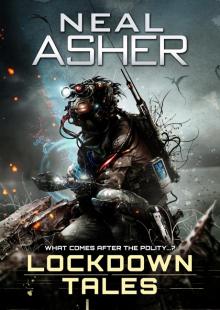 Lockdown Tales
Lockdown Tales The Warship
The Warship Line War
Line War Total Conflict
Total Conflict The Departure
The Departure Owner 03 - Jupiter War
Owner 03 - Jupiter War Polity Agent
Polity Agent Prador Moon
Prador Moon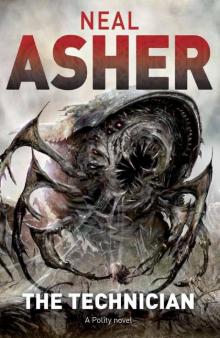 The Technician
The Technician Hilldiggers
Hilldiggers Gridlinked
Gridlinked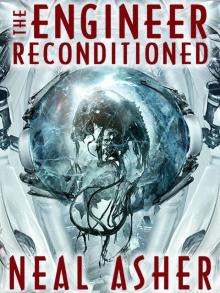 The Engineer ReConditioned
The Engineer ReConditioned Dark Intelligence
Dark Intelligence The Soldier: Rise of the Jain, Book One
The Soldier: Rise of the Jain, Book One Shadow of the Scorpion p-2
Shadow of the Scorpion p-2 The Skinner
The Skinner The Soldier
The Soldier The Gabble p-13
The Gabble p-13 The Gabble and Other Stories
The Gabble and Other Stories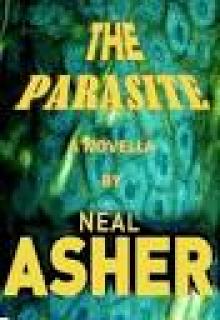 The Parasite
The Parasite The Other Gun
The Other Gun The Line of Polity
The Line of Polity Zero Point (Owner Trilogy 2)
Zero Point (Owner Trilogy 2)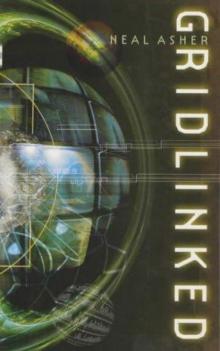 Gridlinked ac-1
Gridlinked ac-1 Prador Moon p-1
Prador Moon p-1 Infinity Engine
Infinity Engine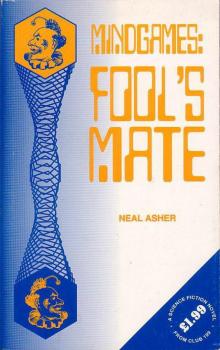 Mindgames: Fool's Mate
Mindgames: Fool's Mate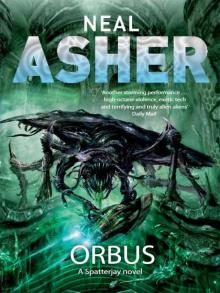 Orbus
Orbus Africa Zero
Africa Zero Line War ac-5
Line War ac-5 Brass Man
Brass Man The Departure to-1
The Departure to-1 Cowl
Cowl Brass Man ac-3
Brass Man ac-3 Hilldiggers (polity)
Hilldiggers (polity)![Greg Bear - [Eon Trilogy 1] - Eon (rescan) (v1.0) Read online](http://i1.bookreadfree.com/i2/04/08/greg_bear_-_eon_trilogy_1_-_eon_rescan_v1_0_preview.jpg) Greg Bear - [Eon Trilogy 1] - Eon (rescan) (v1.0)
Greg Bear - [Eon Trilogy 1] - Eon (rescan) (v1.0)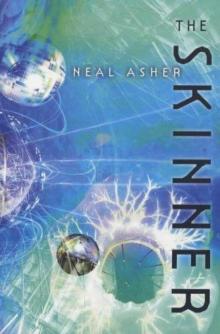 The Skinner s-1
The Skinner s-1 The Voyage of the Sable Keech s-2
The Voyage of the Sable Keech s-2 The Line of Polity ac-2
The Line of Polity ac-2 War Factory: Transformations Book Two
War Factory: Transformations Book Two Polity Agent ac-4
Polity Agent ac-4